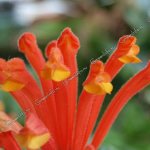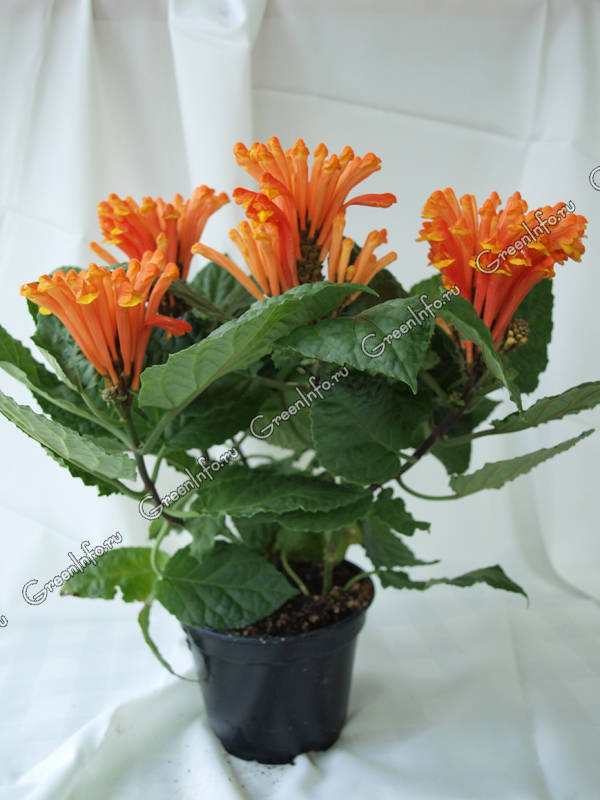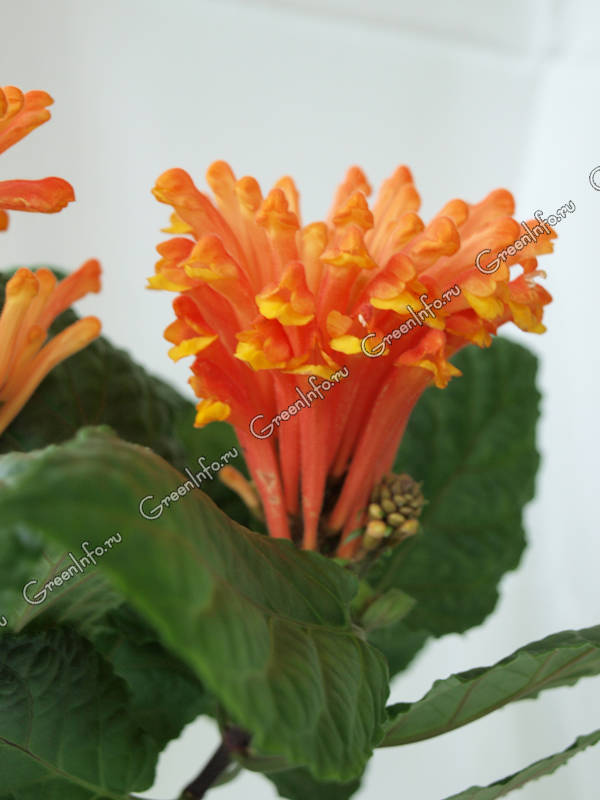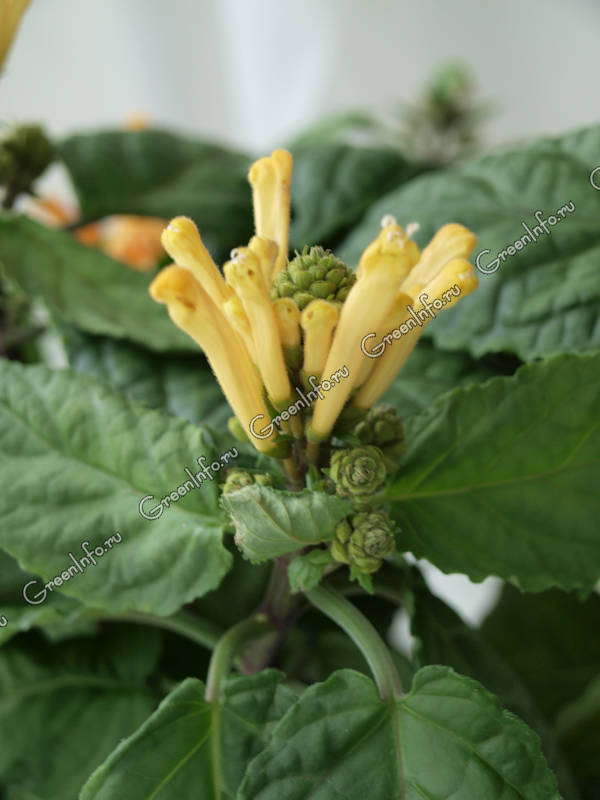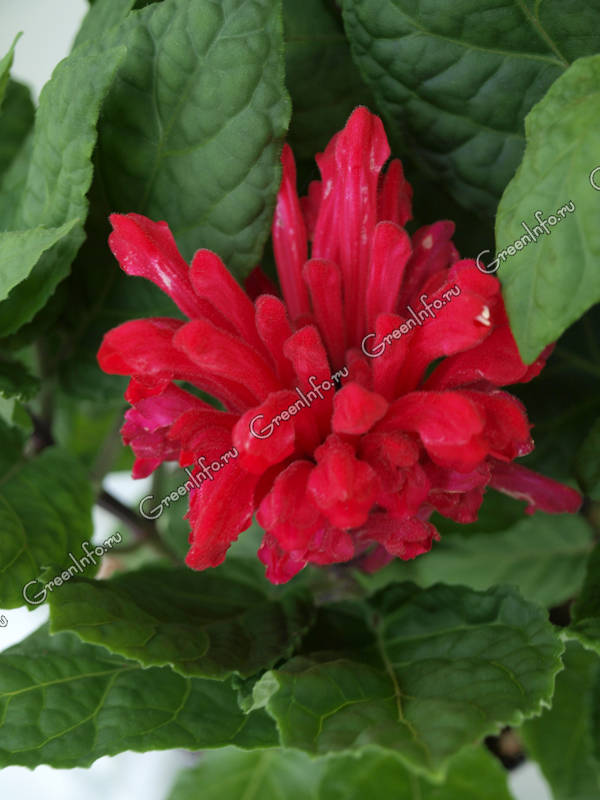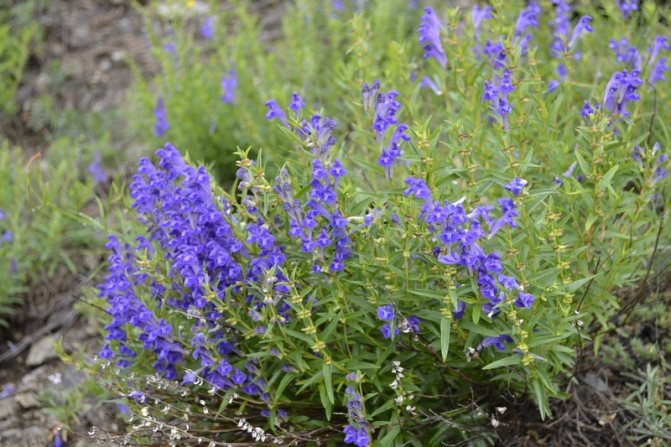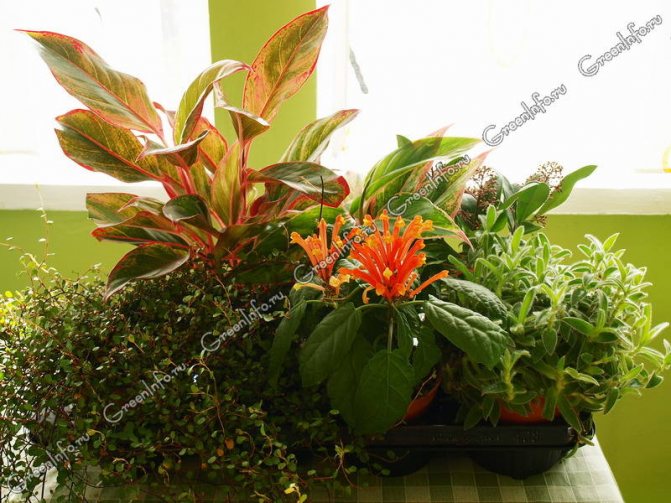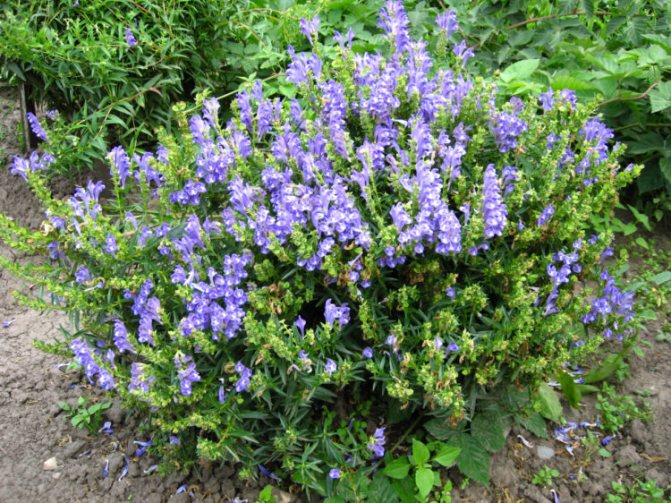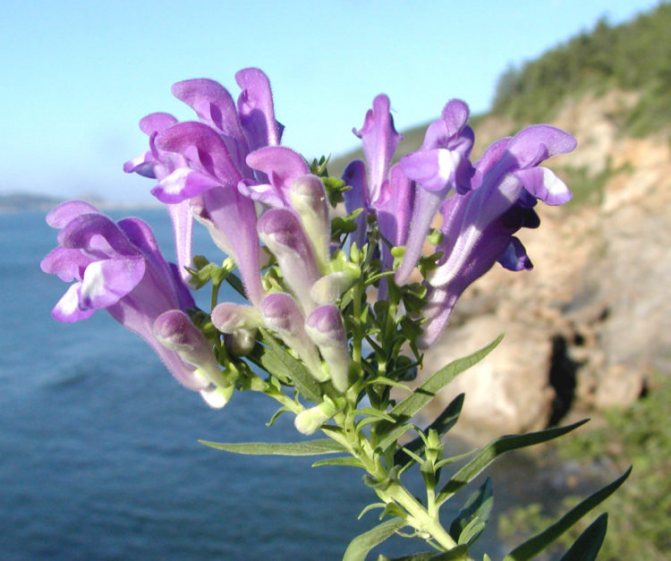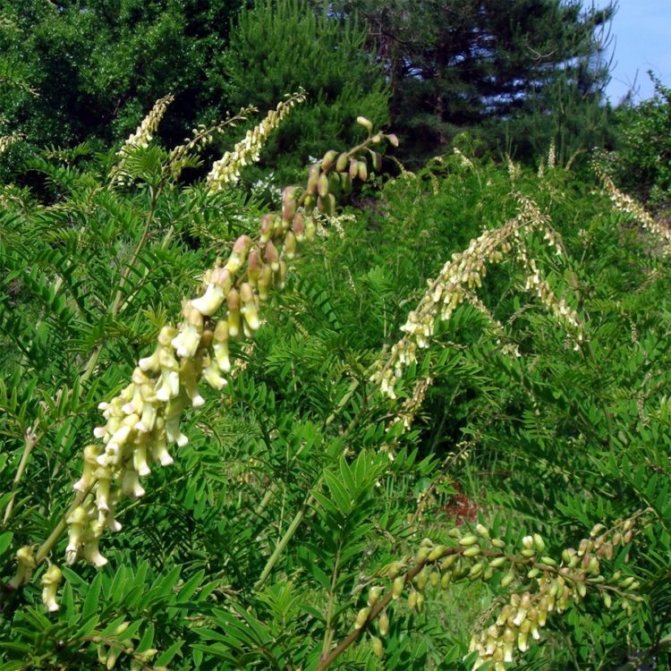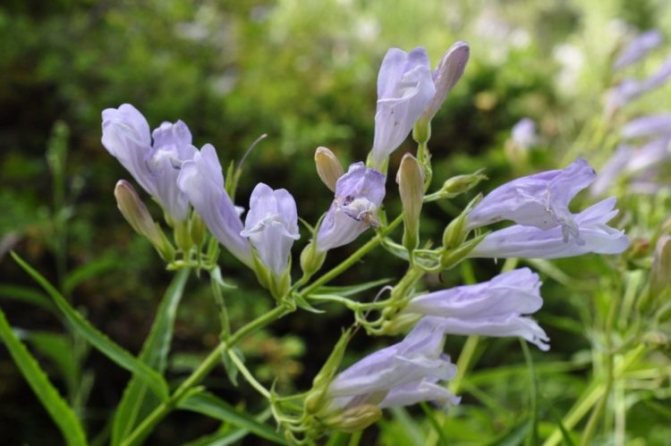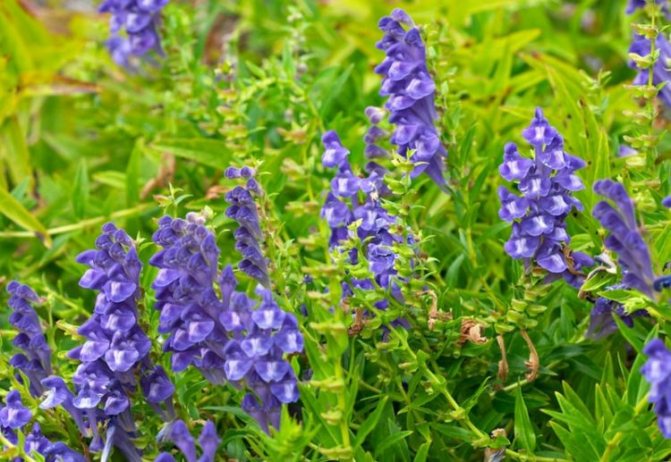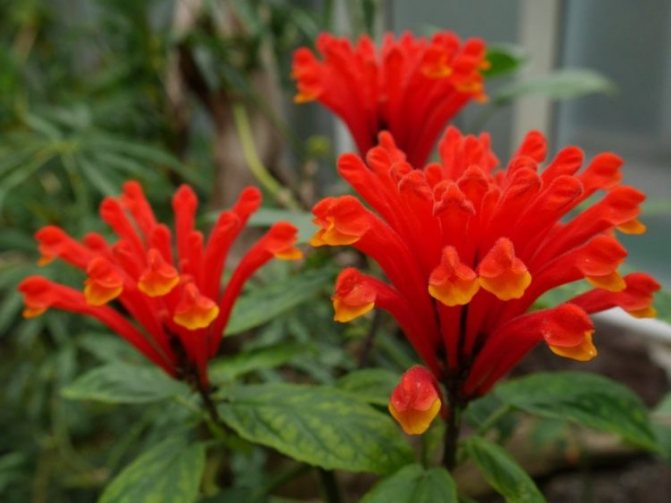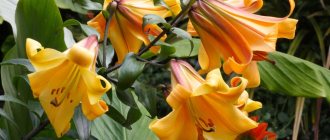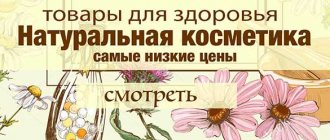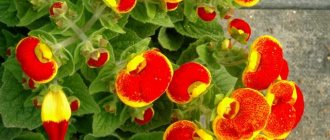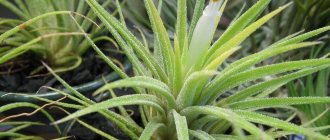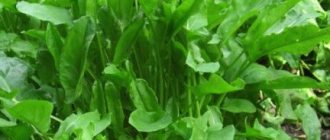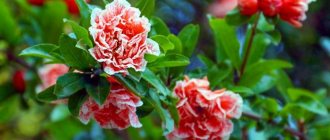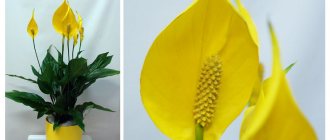Costa Rican scutellaria (Scutellaria costaricana)
Costa Rican scutellaria, or Costa Rican skullcap (Scutellaria costaricana) syn. Scutellaria mociniana belongs to the rather large genus Scutellaria of the Lamiaceae family. Representatives of the genus, and according to the latest data, there are 468, are distributed almost all over the world, except for Antarctica, of which about 98 - in China, several species - in tropical Africa and 1 endemic species - in New Zealand. Many species of skullcap also grow on the territory of Russia, but the most famous of them is the Scutellaria baicalensis, which is a valuable medicinal plant.
Costa Rican scutellaria is the only one of the genus used in indoor culture.
|
|
The name scutellaria is derived from the Latin scutellum (scutellum, scutellum). The upper lip of the flower of all skullcaps has a transverse scale-like fold - a scutellum or a saccular depression. The specific name Costa Rican reflects its natural range. This species was first discovered in Costa Rica and described by the famous botanist and head of the botanical garden in Hanover (Germany) Hermann Wendland. A good taxonomist and a great connoisseur of palm trees, he undertook a year-long journey across Central America in 1856-57, during which he collected herbarium and living specimens of 130 plant species. He was the first to describe and systematize the already known types of palms and other plants, and brought new ones to Europe, which ended up in the botanical gardens of Hanover, Kew, Paris, Berlin, Munich and Vienna. In natural conditions, Costa Rican scutellaria also grows in Panama and Mexico.
In nature, this is a perennial light-loving dwarf shrub with slightly woody stems up to 1 m in height, which, in search of light, can lie down and resemble a ground cover liana, strewn with bright orange-red protruding tubular flowers collected in apical inflorescences. In indoor and greenhouse culture, a natural species with orange flowers is grown, as well as its forms with scarlet, crimson, golden, creamy white flowers.
|
|
In our country, this interesting plant remains quite rare, despite its unpretentiousness and high decorative qualities. A limitation to its wide distribution is the need for periodic renewal by cuttings and cultivation as an annual or biennial.
In indoor culture, the plant reaches a height of 20-60 cm. Stems are tetrahedral, characteristic of labiates due to the opposite arrangement of leaves. Heart-shaped elliptical leaves with a dense green comb edge have a beautiful relief matte surface. When rubbed, they rustle like paper. The essential oil glands of this plant, like all skullcaps, are absent, unlike most labiates, so the leaves do not smell. The flowers are also odorless, formed in the axils of the upper leaves and are collected in spike-shaped inflorescences, in buds resembling cones in shape. Blossom alternately, from top to bottom, due to which flowering is very long. The structure of flowers is not quite typical for labiates - they are two-lipped, with a long, up to 6 cm, red-orange tube, compressed from the sides and forming an angle on the upper part of the flower.The rim folds are yellow, almost completely closed and folded so that they resemble a helmet in shape. For its bright flowers in English-speaking countries, the plant received a second name - Scarlet Sculellaria.
Costa Rican scutellaria is photophilous, but cannot stand direct sunlight. Windows of east, south, west orientation are suitable for it. With a lack of light, the color of the flowers fades. Optimal temperature conditions for development are in the range from +16 to + 200C, although for a short time the plant can tolerate an increase in temperature up to + 290C.
Cold is much more dangerous for scutellaria. As a true Tropicana, it does not tolerate temperatures below + 150C and hypothermia of the root system, to which it reacts with the death of roots. You can not put pots with plants on a cold metal, stone, tile, concrete surface, in such cases, cork or wood coasters can serve well.


Costa Rican scutellaria (Scutellaria costaricana)
Botanical description
A semi-shrub with a woody, curved root, 20-50 cm high.
Stems are numerous, ascending, woody in the lower part, with elongated sinuous purple branches; covered with fine white hairs.
Leaves are ovoid, 2-3.5 cm long and up to 2 cm wide, truncated or cordate at the base, crenate-toothed along the edges, almost glabrous from above, punctate-glandular on the underside, sharp upper leaves with a drawn apex.
Inflorescence is a tetrahedral apical raceme with loosely located false whorls of flowers, sharply separated from the rest of the shoot. The bracts are broadly ovate, pale green or slightly purple. The calyx is about 3 mm long during flowering, densely hairy and glandular. Corolla sulfur-yellow, with a purple upper lip and lateral lobes, large, 22-35 mm long.
The fruit is dry, fractional, splits into four nut-like parts [3] [4].
Priming
Scutellaria soil must be drained to prevent moisture stagnation, and have a light, breathable structure that can be achieved by adding perlite or sand.
The optimal composition of the soil mixture: 1 hour of good garden soil, 1 hour of washed river sand, 1 hour. perlite, 1 teaspoon peat or leaf humus (compost). The acidity of the substrate should be 5.5. You can also use purchased acidic soil with the inclusion of perlite, and even universal, since scutellaria tolerates a weakly acidic reaction and is tolerant of neutral.
Conservation status
In Russia
In Russia, the species is included in the Red Data Books of Belgorod, Volgograd, Voronezh, Kursk, Lipetsk, Oryol, Sverdlovsk and Tula regions, as well as the Republic of Mordovia. It grows on the territory of several specially protected natural areas of Russia [6].
In Ukraine
It is included in the Red Data Book of Ukraine and the Red Data Book of the Luhansk region, it is protected in the department "Cretaceous Flora" of the Ukrainian Scientific and Production Enterprise "Svyatye Gory". It is grown in the Donetsk Botanical Garden of the National Academy of Sciences of Ukraine, the Botanical Garden. A. V. Fomin KNU them. T. Shevchenko [7].
Photo gallery of views
Care


Lighting... Baikal skullcap is an unpretentious plant. He feels especially well in sunny areas, but without direct sunlight, which can burn the delicate flowers of the plant. In shady places, the culture feels quite comfortable, but the lack of sun leads to the fact that the flowers become smaller.- Watering... Skullcap is a drought-resistant plant. Watering skullcap is recommended only during dry periods. Under normal weather conditions, the long root of the plant is able to extract moisture for itself.
- Temperature... The Baikal skullcap is not demanding on the temperature regime. It takes root equally well both in the southern and northern latitudes of our country.
- Priming... The Baikal skullcap does not like heavy black soil. It thrives best on light, neutral, well-drained soils. In the first year, when the root system has not yet matured, it is necessary to periodically loosen the ground and be sure to remove weeds.
- Top dressing... For active growth and beautiful flowering, it is necessary to fertilize the soil.
The feeding scheme of the Baikal skullcap:- The first time fertilization is applied in the fall, before planting the seeds. Mix one bucket of compost (or one and a half buckets of humus) with two glasses of ash, add to one square of earth and dig up.
The next top dressing is carried out during the growing season of the plant, with nitrogen or organic fertilizers.
- During the budding period, potassium-phosphorus fertilizers are applied to the soil.
- Pruning... In the northern regions, it is not necessary to carry out pruning for the winter, so it will better endure the winter. Dried stems are best trimmed in the spring. In the southern regions, pruning can be done in the fall, leaving "hemp" 5-7 cm high.
Be careful with nitrogen fertilizers, as they speed up the growth of the plant stem, but can negatively affect the development of the root system.
Excerpt from Squat Skullcap
- I told you so, - said Alpatych, stepping into his own rights. - Not good guys! - Our stupidity, Yakov Alpatych, - answered the voices, and the crowd immediately began to disperse and scatter across the village. The tied two men were taken to the master's courtyard. Two drunken men followed them. - Eh, I'll look at you! - said one of them, referring to Karp. - How can you talk to gentlemen like that? You thought what? - Fool, - confirmed another, - really, fool! Two hours later, the carts stood in the courtyard of the Bogucharovsky house. The peasants briskly carried and put the master's things on the carts, and Dron, at the request of Princess Marya, released from the locker, where he was locked, standing in the courtyard, was in charge of the peasants. “Don't put it so badly,” said one of the peasants, a tall man with a round smiling face, taking the box from the maid’s hands. - She's also worth money. Why do you just throw it or the floor of the rope - and it will rub. I don't like that. And so that everything is fair, according to the law. Just like that, under the matting, but cover it up with a senz, that's important. Lubo! “Look for books, books,” said another man who was carrying out Prince Andrey's library cabinets. - Don't cling! And it's overweight, guys, the books are healthy! - Yes, they did, they didn’t walk! - With a significant wink, said a tall chubby man, pointing to the thick vocabulary lying on top. Rostov, not wishing to impose his acquaintance on the princess, did not go to her, but remained in the village, awaiting her departure. After waiting for the departure of Princess Mary's carriages from the house, Rostov sat on horseback and up to the path occupied by our troops, twelve miles from Bogucharov, he accompanied her on horseback. In Yankov, at the inn, he said goodbye to her respectfully, for the first time allowing himself to kiss her hand. “Don’t you be ashamed,” he replied, blushing, to Princess Marya in response to the expression of gratitude for her salvation (as she called his act), “everyone would have done the same. If we only had to fight with the peasants, we would not have allowed the enemy so far, - he said, ashamed of something and trying to change the conversation. - I'm only happy that I had the opportunity to meet you. Farewell, princess, I wish you happiness and consolation and wish to meet you under happier conditions. If you don't want to make me blush, please don't thank. But the princess, if she did not thank him more in words, thanked him with all the expression of her face beaming with gratitude and tenderness. She couldn't believe him that she had nothing to thank him for. On the contrary, for her it was undoubtedly the fact that if he were not there, then she probably should have perished both from the rebels and from the French; that, in order to save her, he exposed himself to the most obvious and terrible dangers; and it was even more certain that he was a man with a high and noble soul, who knew how to understand her position and grief. His kind and honest eyes, with tears coming out on them, while she herself, crying, talked to him about her loss, did not leave her imagination.When she said goodbye to him and was left alone, Princess Marya suddenly felt tears in her eyes, and this was not the first time she had a strange question: does she love him? On the way further to Moscow, despite the fact that the princess's position was not happy, Dunyasha, who was riding with her in the carriage, more than once noticed that the princess, leaning out the carriage window, was smiling happily and sadly at something. “Well, what if I fell in love with him? - thought Princess Marya. No matter how ashamed she was to admit to herself that she was the first to fall in love with a person who, perhaps, would never love her, she consoled herself with the thought that no one would ever know this and that she would not be to blame, if she had to the end of her life, no one talking about loving the one she loved for the first and last time. Sometimes she remembered his views, his participation, his words, and it seemed to her that happiness was not impossible. And then Dunyasha noticed that she, smiling, was looking out the carriage window. “And he had to come to Bogucharovo, and at this very minute! - thought Princess Marya. - And it was necessary to refuse his sister to Prince Andrey! - And in all this Princess Marya saw the will of Providence. The impression made on Rostov by Princess Marya was very pleasant. When he remembered her, he felt cheerful, and when his comrades, learning about the adventure with him in Bogucharov, joked to him that he, having gone for hay, picked up one of the richest brides in Russia, Rostov got angry. He was angry precisely because the idea of marrying a pleasant for him, gentle Princess Marya with a huge fortune more than once crossed his mind against his will. For himself personally, Nikolai could not wish for a wife better than Princess Marya: marrying her would make the countess - his mother - happiness, and would improve the affairs of his father; and even - Nikolai felt it - would have made Princess Marya happy. But Sonya? And the given word? And this made Rostov angry when they joked about Princess Bolkonskaya.
Photo
Below are photos of this shrub.
Grass Skullcap or Shlemnik Baikal and its beneficial properties
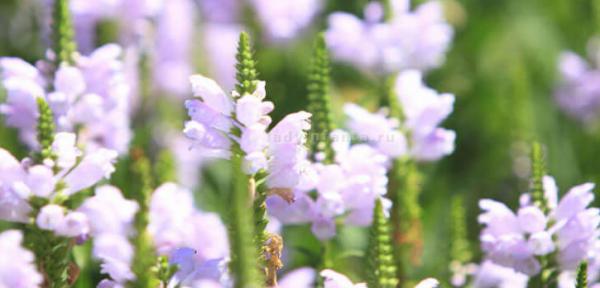

1 the skullcap herb may help fight cancer cells
Research shows that Chinese skullcap extract is toxic to cancer cells. These include brain cancer cells, prostate cells, and head and neck squamous cell carcinoma cell lines. Studies show that water extracts inhibit the growth of lymphoma and myeloma cells.
Certain flavones, which are antioxidants in the plant, are thought to be responsible for these anti-cancer effects, ultimately inhibiting growth. This can be due to the free radical scavenging properties that Skullcap herb contains. Subsequently, preventing viral infections.
One of these flavones is known as baicalein. A study published in the Beijing Science Bulletin found that baicalein does not cause mutations. This is a major problem with many of the traditional cancer drugs available today.
Another study, published in the International Journal of Molecular Medicine, investigated the effects of skullcap extract on fibrosarcoma. It is a highly metastatic cancer of the connective tissue. It showed possible anti-tumor properties.
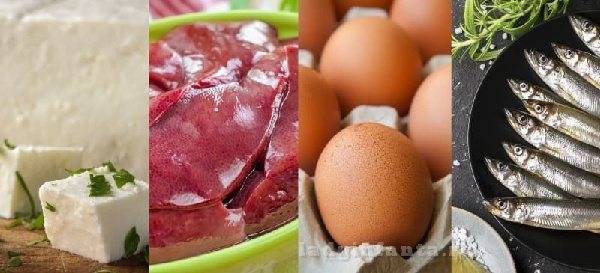

Indications for use
Medicinal herb is used to treat the following diseases and ailments:
- hypertension;
- arrhythmia;
- spasms of the digestive and excretory systems;
- insomnia;
- nervous disorders;
- intense fever;
- infection with worms;
- heavy bleeding;
- toxicosis during pregnancy;
- constipation;
- stagnation of bile;
- hepatitis;
- gastroenteritis;
- diabetes;
- nephritis;
- rheumatism;
- whooping cough;
- bronchitis;
- pneumonia;
- tuberculosis;
- meningitis;
- angina;
- epilepsy;
- allergic rashes.
It is worth noting that certain medical conditions require ingredients that are difficult to obtain.Skullcap is widely used in Japanese and Chinese medicine, respectively, medicines contain ingredients that are not common in our country. We have only indicated a complete list of diseases and ailments that a medicinal plant can cope with.
Did you know? Scoop is also called a plant like Dzhungarian aconite. The danger lies in the fact that aconite is one of the most poisonous plants in the world and grows in the same regions as Baikal skullcap. Outwardly, it is quite simple to distinguish the plants, but the dangerous aconite has inflorescences of the same color as the Baikal namesake.
Reproduction
Seeds
To grow skullcap from seeds, the soil is carefully leveled before sowing. Seeds are sown in open ground at the end of April - in May, depending on the climatic conditions of the region. The seeding depth of the seeds is 0.7 cm. The sowing of an ordinary in the furrows, the distance between the rows is 30-35 cm. Seedlings appear on the 12-15th day, weak, uncrushed. They need weeding and loosening to increase the oxygen content in the topsoil. After watering, the soil is mulched to prevent crust formation.
If the seedlings are dense, they can be planted no later than the formation of 3-4 true leaves. Plants are carefully removed along with a clod of earth and transferred to a new place. The transplanted plant must be watered with a root solution. A later transplant is not advisable. Plants hardly take root because of the taproot, which is damaged during transplantation. In this case, the plants are simply thinned out.
In the northern regions, it is better to plant skullcap through seedlings. Sowing seeds in prepared containers is carried out in March in greenhouses, hotbeds or in boxes, turning them into temporary mini-greenhouses. The soil is kept moist. After emergence (10-12 days), the seedlings dive into boxes or (if the weather permits) at the beginning of June directly into the ground, after 30-40 cm. Scutellaria plants bloom for 2 years.
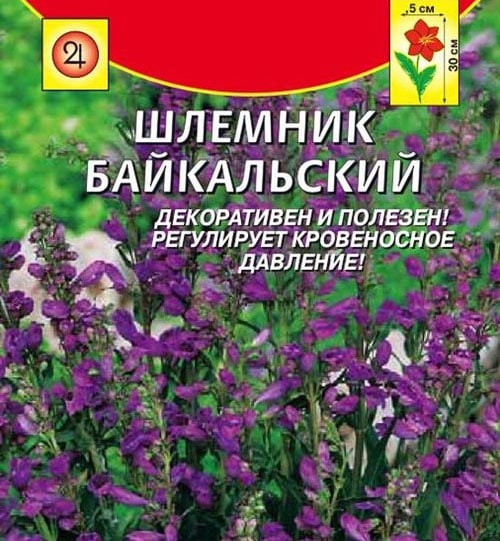

Scutellaria seeds are easy to purchase
By dividing the bush
If the skullcap is grown as an ornamental crop, then to preserve the maternal traits (color, flower size, etc.), reproduction is carried out by dividing a three-year-old bush. Vegetative propagation of skullcap is more difficult than by seeds, which is associated with the taproot. The bush is dug up, shaken off the soil. With a sharp knife, the rhizome is divided into parts so that each division has a bud of renewal. The wound surface of the rhizome is sprinkled with finely crushed coal. A pit for planting is prepared according to the size of the cut, 10-15 g of nitroammophoska or urea with phosphorus-potassium fertilizer are added. Water and plant the cut with the renewal bud upwards.


Skullcap can be purchased at pharmacies
Recommendations and reviews
Common scullcap, Baltic, Altai are widely used in folk and official medicine in many countries. Numerous positive reviews about Scutellaria Baikal made infusions, extracts, capsules and tablets, as well as other preparations, very popular both in our country and among foreign consumers. Dry vegetable raw materials allow for the independent preparation of decoctions and infusions based on the root of the medicinal culture:
- to prepare a medicinal broth, four tablespoons of dry vegetable raw materials need to be poured into ½ liter of boiling water, then stand for a quarter of an hour in a water bath and insist for about two hours at room temperature. You need to take the broth in a tablespoon three to four times a day;
Horseradish ordinary: all about the benefits and dangers of the plant
Diseases
- Knowing about the moisture-loving nature of this plant, many growers water it too hard, because of which the water in the pots stagnates, and the roots begin to rot. This is the most common scutellaria care mistake. With root decay, only correction of the irrigation regime can help.
- Another common problem is fungal infection. They also tend to develop from excessive waterlogging.
- Of the pests, aphids are the most dangerous. Less commonly, thrips and spider mites can infect the plant.
The Shlemnikov family is extremely diverse.... Among the species of Scutellaria, there are not only medicinal plants - there are also many ornamental species, however, for home cultivation, the most exotic one is the most exotic - Costa Rican scutellaria. This bright and beautiful plant, unlike most exotic plants, is easy to grow at home, which makes it even more popular.
Medicinal use
One of the 50 main herbs used in traditional Chinese medicine for over 2000 years. The Baikal skullcap is mainly used for inflammation or infection, as well as for calming the nerves and reducing anxiety. Also used to treat:
- fever;
- jaundice;
- dysentery;
- diarrhea;
- urinary tract infections;
- liver disease;
- prostate cancer;
- respiratory infections;
- arthritis.
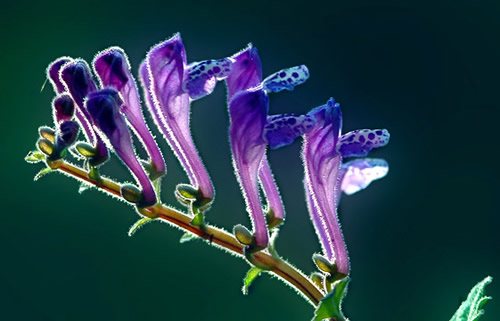

Modern research has discovered a significant efficacy of the active chemicals found in the root of this plant. However, these studies have not been sufficiently conducted to determine the effective dosage level and the precise benefits of each ingredient.
Potentially, these substances have antibacterial, anti-inflammatory, anti-cancer, anti-anxiety, antihypertensive properties. They also reduce anti-allergenic activity, sedation and anxiety, and help with respiratory ailments including hay fever and allergic skin conditions such as eczema and psoriasis.
The Baikal skullcap is of little low-order toxicity, as most people are unlikely to suffer from normal use. The active ingredients in this plant can react with alcohol and certain medications, including lithium, sedatives, and statins are used to treat high cholesterol and diabetes. In some people, this plant causes drowsiness, an allergic reaction, or leads to liver problems. The Baikal skullcap should be avoided by pregnant or breastfeeding women.
Scutellaria baikal root
The root of the plant is used for traditional medicine. The active ingredients take time to accumulate, so the roots should only be harvested on 3-4 year old plants, preferably in spring and autumn. The collected roots should be dried in a partially shaded and well-ventilated area. They can be used whole or cut. Note, however, that good quality roots should be brown on the outside and yellow on the inside, not green or black.
It is cultivated commercially due to the high levels of flavonoids found in the roots of 3-4 year old plants. Active chemicals include baicalin, wogonin, and baicalin.
Structure
The use of Scutellaria Baikal, like any other plant, depends on its fiber content. Since its aerial parts in folk medicine are almost never used, in the future we will focus on the composition of its roots.
Skullcap differs from aconite in the absence of aconitine - one of the most effective poisons from the group of alkaloids. But in its chemical composition there are two other no less exclusive (except for skullcaps, they are nowhere else) compounds: baicalin and vogonin. They are not alkaloids, but bioflavonoids. In the human body, they serve as antioxidants - substances that can slow down some of the oxidation processes that are destructive for cells. In addition, the Baikal skullcap contains other components.
- Tannins. Moreover, in a significant amount (up to 4%). They are also poisonous, since they serve as a plant's self-defense system from pests, rodents, birds and other threats typical of them.
- Starch. Potato tubers are almost pure starch, not skullcap roots. For our metabolic system, it acts as a source of sugar - simple carbohydrates.
- Coumarins. Compounds that inhibit the growth of the plant itself and accelerate the maturation of its seeds, which can perform the functions of light anticoagulants, antispasmodics or antitumor agents in the human body.
- Saponins. Natural soap base that cannot be absorbed by the body. When it enters the digestive tract, it causes stool disorders, which may come in handy except for constipation.
- Phytosterols. Plant "analogues" of cholesterol in animals and humans. Their use may be important in cardiovascular diseases (due to their ability to reduce the absorption of cholesterol from food by the intestinal walls). But otherwise they do not play a significant biological role.
- Micro and macro elements. Mainly calcium and potassium, zinc, selenium, magnesium.
Making preparations based on a plant
The Baikal skullcap is not as poisonous as many of its "relatives". Plus, it has proven anticancer and hepatoprotective properties. Therefore, although it is not currently included in the list of medicinal plants, its extract and alcohol tincture can be bought at the pharmacy. But if required, home remedies can also be prepared using fairly simple recipes.
To do this, it is permissible to use fresh Scutellaria baikal root, but it will be better to dry it - this way it is stored longer and is more convenient to use. Roots are dried in the shade, outdoors or in well-ventilated areas (if there is time and the weather is right). But you can spread it out on a baking sheet covered with culinary parchment and dry it in the oven over medium heat.
Before using the root of Scutellaria Baikal, you need to take into account the precautionary rules.
- Collection. It is better to collect and cut fresh Scutellaria Baikal root with gloves.
- Treatment. You cannot breathe the dust of dry raw materials during grinding, you should wear a respirator.
- Drying. You should not dry and cook the root of Scutellaria Baikal in closed rooms.
- Storage. Store the dry root of Scutellaria Baikal in a hermetically sealed glass / tin container, separate from food.
- Cleaning tools. All used tools and utensils, including the oven, then need to be thoroughly washed, and consumables should be thrown away.
- Care with waste. Disposable items used for root processing, as well as waste, should be thrown away where children and pets cannot accidentally reach them.
- Storage of drugs. Alcohol extracts of Scutellaria baikal should be hidden if there are children and relatives suffering from alcoholism in the house.


Home tincture
You will need:
- half a liter of moonshine or alcohol with a strength of 70% or more;
- 50 g of dried Scutellaria Baikal root;
- glassware with a tight lid.
Preparation
- Cut the dry root of Scutellaria Baikal into small pieces, put in a glass jar and cover with alcohol.
- Close the lid and leave to infuse in a dark, cool place for 20 days.
- Once a day, take out the dishes with the tincture, shake without opening, and put back.
- At the end of the infusion period, carefully strain the product through a double-folded gauze.
To take Scutellaria Baikal prepared in this way, you need 15-20 drops, three times a day, ten minutes before meals, dissolving them in half a glass of any unsweetened, non-carbonated drink. If gastritis / ulcers are present or treated, it is best to dissolve the product in a full glass of water / drink. The course of treatment is a month. Then you need to take a two-week break, and in the absence of side effects, resume therapy.
Water infusion
You will need:
- 50 g of dried Scutellaria Baikal root;
- a glass of boiling water;
- thermos with a glass inner flask.
Preparation
- Cut the root of Scutellaria Baikal smaller, put it in a thermos.
- Pour boiling water over, cover and shake several times like a shaker.
- Leave to infuse for an hour, then discard in a colander or strain through cheesecloth, squeeze out the raw materials.
You can take an infusion of Scutellaria Baikal for gastritis, pancreatitis, duodenitis, ulcers, polyps and rectal fissures. This should be done in three doses in approximately equal portions within one day, before meals, without diluting. The course of treatment is two weeks. It is better to prepare a daily portion of the product daily, and not immediately for the entire course - it is easier to preserve and emphasize all the medicinal properties of Scutellaria baikal. After the course, you need to take a five to seven days break and continue treatment.
Skullcap Baikal - photos and properties of the plant
Therapeutic properties
All plant poisons, including tannins, alkaloids and some flavonoids, are destructive not only for the cells of the human body. They are equally, if not more, toxic to fungi, helminths, many protozoa, bacteria that can parasitize in the human body. They are also dangerous for malignant cells of the body.
Therefore, the main indications for the use of skullcap of Baikal relate to inflammatory, infectious, malignant processes, including:
- joint pain - an elucidated or unclear cause (etiology), including age-related, infectious, traumatic and even gouty;
- hypertension - since almost all plants of the lamb family, including Scutellaria Baikal, are distinguished by a pronounced ability to lower blood pressure;
- oncology - everything, including precancerous conditions (cutaneous horn, cervical hyperplasia), lymphomas, myeloma;
- gastrointestinal diseases - especially foodborne infections and light poisoning, but also appendicitis, intestinal and stomach polyposis, aseptic inflammation of all parts of the intestine, rectal fissure, hemorrhoids;
- spasms and convulsions - with a general tendency to them, as well as if they are caused by a separate pathology (epilepsy, cerebral palsy);
- liver pathology - as a good choleretic and anti-inflammatory agent;
- skin diseases - not only cancer and precancer, but also acne, erysipelas, furunculosis, lichen;
- respiratory diseases - from acute respiratory viral infections and tonsillitis to pneumonia;
- blood diseases - including not only leukemia, but also anemia of benign etiology;
- pathologies of the genitourinary system - from commonplace candidiasis to cervical cancer, prostatitis, endometriosis, adhesions and cysts;
- purulent wounds - regardless of their origin and type of infection;
- uterine and other bleeding - due to the pronounced properties of the coagulant.
Benefits for beauty
Cosmetology does sometimes use Scutellaria extracts in care products, however, usually without indicating the proportions in which it is added there. However, in the overwhelming majority of cases, we are not talking about rejuvenating (age-related) ones, but about “problem” product lines. That is, created to combat the oily sheen of problem skin or hair, color irregularities, seborrhea, inflammation. This fact proves that cosmetologists perceive Baikal skullcap as a good antiseptic, but nothing more. Although it stimulates the regeneration of the corneous cells of hair, nails and skin, giving a rejuvenating effect.
Effect on the endocrine glands
With regard to diseases of the thyroid and pancreas, then we are talking about the appointment is even more dubious. Scutellaria Baikal extract really helps to control inflammatory and malignant processes in them, but only if they are present, which does not always happen. This does make the disease a little easier, although it does not cure it.
Growing conditions
The Baikal skullcap prefers sunny places, if possible with slightly fertilized, dryish soil. The effectiveness of the active chemicals in the roots is much greater when grown in poor sandy soils. The plant has an average water requirement and is drought tolerant. It is quite hardy, therefore it easily tolerates low temperatures and frosts. Temperatures in their natural habitat are usually quite low.
Although this herb is perennial, it is advisable to replenish it with new plants every three years. Seeds for the Baikal skullcap can be sown in spring or split before new shoots appear in spring. Large sections can be planted immediately, while small sections can be stored in pots until ready to be planted in the garden. Woody or soft stem cuttings can also be taken, and many people successfully breed this plant this way. Skullcap is also suitable for growing in containers.

